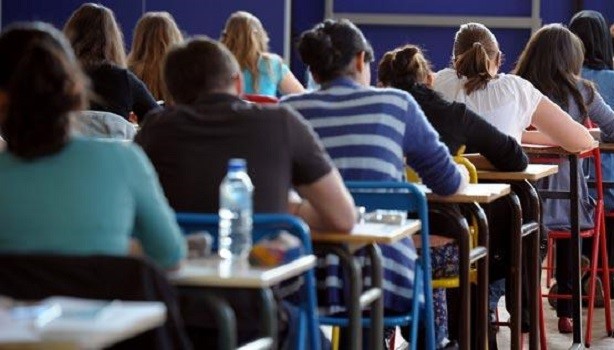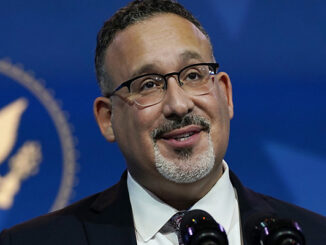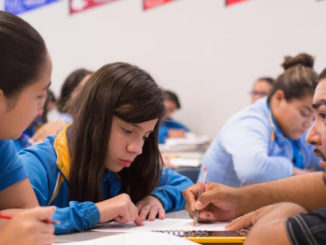
By Catherine Gewertz
The number of students taking the SAT has hit an all-time high, but how well they’re doing is a bit of mystery.
The College Board released its annual performance report on Tuesday, which shows that 1.8 million students in the graduating class of 2017 took the exam, more than in any previous class. They scored an average of 527 in math and 533 in reading and writing. Each section is measured on a 200-800 scale.
But the College Board didn’t release year-to-year performance changes as it typically does. That’s because 1.7 million students—93 percent of the class of 2017—took the redesigned SAT that debuted in March 2016. It’s a different test, on a different scale, so the scores from the two years aren’t equivalent, they said.
This year’s scores reflect students’ performance only on the new SAT. Last year’s—508 in math, 494 in reading, and 482 in writing—reflect performance only on the old SAT.
In redesigning the SAT, the College Board aimed to build a more straightforward test that reflects the strengths students will need for college. It dumped obscure vocabulary words in favor of requiring students to justify their answers. It covers fewer math topics, but in more depth. It’s also shorter, with no penalty for wrong answers.
What appear to be big scoring increases should be understood not as sudden jumps in achievement, but as reflections of the differences in the test and the score scale, psychometricians said. Even though the numerical scale—200 to 800 for each section—is the same, a 425 on the new test measures a different level of achievement than a 425 on old test, they said.
“We all noticed how much higher the scores from the new SAT were,” said Jennifer Winge, the dean of admissions at Wooster College in Ohio, said of the scores she saw coming in.
A College Board representative warned Winge and her staff to anticipate higher scores overall on the new test, she said. But she didn’t quite trust the conversion tables, and that made it tough to figure out how much weight to assign the new SAT scores in admission and scholarship decisions, she said.
“Frankly, the whole process just pushed us further into our consideration of going test-optional,” Winge said.
The 2017 SAT scores show inequities similar to those of earlier years. Asian (1181), white (1118), and multiracial (1103) students score far above the average composite score of 1060, while Hispanic (990) and African-American (941) students score significantly below it.
Because the new test is reported for two sections instead of three, the maximum composite score a student can get is now 1600 rather than 2400 for the previous version.
Likewise, scores continue to correlate with family educational background. The composite average score of students whose parents have bachelor’s degrees (1118) far outstrips the average of students whose parents have only a high school diploma (1003).
Readiness Benchmarks
Only 46 percent of students met the minimum scores that the College Board has correlated with a good likelihood of succeeding in entry-level, credit-bearing college coursework. Even in the transition years when the old SAT is being replaced by the new, and quantifying score changes is elusive, that’s still bad news, said Phillip Lovell, the policy director of the Alliance for Excellent Education, which focuses on high school improvement.
“Less than half of our kids meeting the college-readiness benchmark? That’s just not good. And it’s not sustainable” in a country that is striving for better college outcomes, he said.
More students are taking the SAT largely because the College Board has been pushing hard to win contracts with entire states or districts. Under those agreements, all students can take the college-admission test for free, or are required to take it, a move often aimed at increasing college access and enrollment. A recent study found that college-enrollment increases among low-income students in states that offer the SAT or ACT for free. Also, increasingly, states are choosing college-entrance exams as their official way to measure student achievement at the high school level.
College Board officials announced an expansion of that contract work. Starting in December, they said, schools—not just districts and states—can negotiate contracts to administer the SAT during the school day.
The contract battle between ACT and the College Board showed big gains for the College Board this year. Participation in its “school day” program rose from 458,000 in 2015-16 to 800,000 in 2016-17, powered in part by Michigan’s decision to switch from the ACT to the SAT.
The ACT currently has contracts with 19 states, and is still the nation’s most popular college-admission test: 2.03 million students in the class of 2017 took it. The College Board has contracts with 10 states, the District of Columbia, and more than 250 districts. But company officials said they anticipate 200,000 more students in their testing pool next year, which could make the two exams about equal in popularity.
Building the Pipeline
The College Board is working to build business not just with the SAT, but with a suite of PSAT tests. There are now three PSAT tests in the suite: the redesigned PSAT, aimed at 11th grade students; the PSAT 10, and the PSAT 8/9. Figures released by the College Board show a modest one-year increase for the PSAT and the PSAT 10: 4.3 million students, 46,000 more than in 2016-17. But the PSAT 8/9 showed a big gain, 47 percent, up to a total of 1.3 million students in 2016-17.
Average scores on the PSAT exams rose in all grade levels, according to the College Board. The company envisions the collection of PSAT and SAT exams, along with its “official SAT practice” provided free, online, by Khan Academy, as a way schools can shift focus from short-term test prep to building instructional strength over time.
“We do not believe that a one-time test at the end of students’ careers will change things,” David Coleman, the College Board CEO, told reporters in a conference call last week. “We are more interested in sustained work that changes students’ trajectories. That won’t come in narrow spurts of last-minute preparation.”
James S. Murphy, who tracks changes in testing as the director of national outreach for the Princeton Review, which offers test-preparation courses, said that in its increasing emphasis on the PSAT and SAT tests, the College Board is downplaying the SAT subject tests, which have been declining in popularity, and were dropped from this year’s score report.
“It just shows their shifting priorities,” Murphy said.
Doubts persist about using a college-admissions exam as a measure of student achievement, in part because of who takes the test—and who doesn’t.
Lauress Wise, the former president of the National Council on Measurement in Education, an association of psychometricians, said an accurate measure of achievement requires giving a test to a nationally representative pool of test-takers who take the exam under the same circumstances.
With both the SAT and the ACT, he noted, some students in the pool chose to take the test, while others, in entire states or districts, were required to take it as part of a testing contract.
Catherine Gewertz is an associate editor for Education Week. She covers assessment, and pathways through middle and high school. She is the author of the blog High School & Beyond.
Send an email to Catherine Gewertz.



